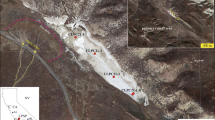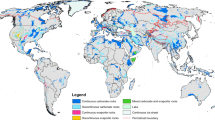Abstract
Beach-bar deposits are very common in the shallow-water zone of lacustrine basins, and have been an attractive exploration target within lacustrine basins, where numerous lacustrine beachbar oil pools have been discovered recently. Physical criteria for recognizing lacustrine beach-bar deposits are important not only for reconstruction of paleoenvironments and paleoshorelines, but also for the exploration and development of hydrocarbon. Modern beach-bars, 162 km in length, in Qinghai Lake, Qinghai-Tibet Plateau, were studied in detail based on lithology, sedimentary structure, texture, basal contact, bed thickness and dip angle, mean grain size, sorting, skewness, sedimentary succession, etc. The study found that the gravel beach-bars have a fixed sedimentary succession, “ABC” sequence, which is composed of A, B, and C intervals. The A interval is characterized by poorly sorted pebbly sandstones, the B interval is characterized by well sorted conglomerates and the C interval is characterized by normally graded sandstones. The A, B, and C intervals have particular quantitative characteristics, including mean grain size, sorting, skewness, dip angle of layers, and thickness of layers. The gravel beach-bar deposits can be presented in different combined pattern, such as “ABCABC”, “ABABAB”, and “BCBCBC”. The beach-bars deposits are stripe-like, parallel to the shoreline, and with convex tops and flat bottoms. The length of the beach-bars can be tens of kilometers. The width of the beach-bars can be thousands of meters.
Similar content being viewed by others
References
Adikaram, M., Pitawala, A., Ishiga, H. and Jayawardhana, D. (2017) Paleoenvironmental reconstruction of quaternary sedimentation in eastern Sri Lanka: An ichnological study. Jour. Geol. Soc. India, v.89, pp.71–76.
Alberti, M., Fürsich, F. T., Pandey, D. K., and Mukherjee, D. (2017) Overview on the middle to upper Jurassic sedimentary succession of Gangta Bet in the Kachchh basin, western India, with special emphasis on its lithostratigraphy, biostratigraphy, and palaeoenvironment. Jour. Geol. Soc. India, v.89(3), pp.259–270.
Basilici, G. (1997) Sedimentary facies in an extensional and deep-lacustrine depositional system: the Pliocene Tiberino Basin, Central Italy. Sediment. Geol., v.109(1–2), pp.73–94.
Campbell, C.V. (1971) Depositional model—upper Cretaceous gallup beach shoreline, ship rock area, northwestern New Mexico. Jour Sediment. Petrol., v.41(2), pp.409–495.
Deng, H., Xiao, Y., Ma, L., and Jiang, Z. (2011) Genetic type, distribution patterns and controlling factors of beach and bars in the second member of the shahejie formation in the dawangbei sag, bohai bay, china. Geol. Jour., v.46(4), pp.380–389.
Dietze, E., Hartmann, K., Diekmann, B., IJmker, J., Lehmkuhl, F., Opitz, S., Stauch, G., Wünnemann, B., and Borchers, A. (2012) An end-member algorithm for deciphering modern detrital processes from lake sediments of Lake Donggi Cona, NE Tibetan Plateau, China. Sediment. Geol., v.243, pp.169–180.
Dyhr-Nielsen, M. and Sørensen, T. (1970) Some sand transport phenomena on coasts with bars. In: Coastal Engineering 1970, pp.855–865.
Folk, R.L. (1966) A review of grain-size parameters. Sedimentology, v.6(2), pp.73–93.
Huang, C., and Bhattacharya, J.P. (2017) Facies analysis and its relation to point-sourced growth faults in river-dominated prodeltaic delta front deposits of the Cretaceous Ferron Notom Delta, Utah, USA. Marine Petrol. Geol., v.81, pp.237–251.
Ji, C. (2016) The Study on Mordern Sedimentary System in the Qinghai Lake. Edited. China University of Geosciences, Beijing.
Jia, H., Ji, H., Li, X., Zhou, H., Wang, L., and Gao, Y. (2016) A retreating fand elta system in the Northwestern Junggar Basin, northwestern China—Characteristics, evolution and controlling factors. Jour. Asian Earth Sci., v.123, pp.162–177.
Jiang, Z. (2003) Sedimentology. Petroleum Industry Press, Beijing.
Jiang, Z., Liang, S., Zhang, Y., Zhang, S., Qin, L., and Wei, X. (2014) Sedimentary hydrodynamic study of sand bodies in the upper subsection of the 4th Member of the Paleogene Shahejie Formation the eastern Dongying Depression, China. Petroleum Sci., v.11(2), pp.189–199.
Jiang, Z., Liu, H., Zhang, S., Su, X., and Jiang, Z. (2011) Sedimentary characteristics of large scale lacustrine beach-bars and their formation in the Eocene Boxing Sag of Bohai Bay Basin, East China. Sedimentology, v.58(5), pp.1087–1112.
Li, P., Pang, X., Chen. D., Zhang, S., Jin, Z., and Jiang, Z. (2004) Formation mechanism and model for sand lens reservoirs in the Jiyang Sub-basin, East China. Science in China Ser. D Earth Sci., v.34(1), pp.167–176.
Li, X.Y., Xu, H.Y., Sun, Y.L., Zhang, D.S. and Yang, Z.P. (2007) Lake-level change and water balance analysis at Lake Qinghai, west China during recent decades. Water Resources Management, v.21(9), pp.1505.
Liu, C., and Wang, P. (2013) The role of algal blooms in the formation of lacustrine petroleum source rocks—evidence from Jiyang depression, Bohai Gulf Rift Basin, eastern China. Palaeogeo., Palaeoclimat., Palaeoeco., v.388, pp.15–22.
LZBCS. (1994) Evolution of Recent Environment in Qinghai Lake and its Prediction. Science Press, Beijing.
Monroe, S. (1981) Late Oligocene-early Miocene facies and lacustrine sedimentation, upper Ruby River basin, southwestern Montana. Jour. Sediment. Res., v.51(3), pp.939–951.
Nott, J. (2014) Grain size and the origin of wave constructed beach ridges. A Discussion ofBeach ridges and prograded beach deposits as palaeoenvironment records’. Earth-Science Rev., v.132, pp.82–84.
Olariu, C., and Bhattacharya, J. P. (2006) Terminal distributary channels and delta front architecture of river-dominated delta systems. Jour. Sediment. Res., v.76(2), pp.212–233.
Otvos, E.G. (2000a) Beach ridges—definitions and significance. Geomorphology, v.32(1), 8pp.3-108.
Pan, Y., Zong, G., Guo, Y., Jiang, X., and Zhuo, Q. (2003) Terrestrial sequence stratigraphy and lithological deposit group of sand stone in jiyang faulted lacustrine basin. Acta Petrolei Sinica, v.24(3), pp.16–23.
Petryshyn, V. A., Rivera, M. J., Agiæ, H., Frantz, C. M., Corsetti, F. A., and Tripati, A. E. (2016) Stromatolites in Walker Lake (Nevada, Great Basin, USA) record climate and lake level changes~ 35,000 years ago. Palaeogeo., Palaeoclimat., Palaeoeco., v.451, pp.140–151.
Reading, H.G. (1978) Facies models. Springer Berlin Heidelberg. pp.434–444.
Reid, I., and Frostick, L.E. (1985) Beach orientation, bar morphology and the concentration of metalliferous placer deposits: a case study, Lake Turkana, N Kenya. Jour. Geol. Soc. London, v.142(5), pp.837–848.
Smith, L. N. (2017) Repeated sedimentation and exposure of glacial Lake Missoula sediments: A lake-level history at Garden Gulch, Montana, USA. Quaternary Sci. Rev., v.155, pp.114–126.
Sun, Y., Li, X. Y., and Xu, H. (2007) Daily precipitation and temperature variation in Qinghai Lake watershed in recent 40 years. Arid Meteorology, v.25(1), pp.7–13.
Tamura, T. (2012) Beach ridges and prograded beach deposits as palaeoenvironment records. Earth-Science Rev., v.114(3), pp.279–297.
Xiyan, Y., Zhaoguo, S., and Shaoxian, F. (2007) Sedimentary characteristics of beach and bar sand bodies in the lower submember of Member 8 of Xiashihezi Formation of Middle Permian in Wushenqi gasfield, Ordos Basin. Jour. Palaeogeo., 9(2), pp.175–183.
Zhao, D., Zhu, X., Dong, Y., Dong, W. U., and Zhu, M. (2014) Application of seismic sedimentology to prediction of beach and bar sand bodies in gentle slope of lacustrine basin: a case study of the lower cretaceous in chepaizi area, junggar basin, nw china. Petroleum Exploration & Development Online, v.41(1), pp.60–67.
Zhu, X. M., Xin, Q. L., and Zhang, J. R. (1994) Sedimentary characteristics and models of the beach-bar reservoirs in faulted down lacustrine basins. Acta Sedimentologica Sinica.
Author information
Authors and Affiliations
Corresponding author
Rights and permissions
About this article
Cite this article
Peng, B., Jin, Z., Zhu, X. et al. Physical Criteria for Recognition of Lacustrine Gravel Beach-bar Deposits using Modern Examples, the Qinghai Lake, Qinghai-Tibet Plateau, China. J Geol Soc India 91, 722–728 (2018). https://doi.org/10.1007/s12594-018-0930-x
Received:
Accepted:
Published:
Issue Date:
DOI: https://doi.org/10.1007/s12594-018-0930-x




